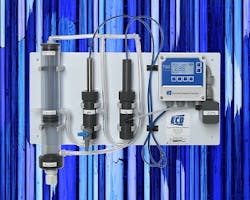Improving Chlorine Measurement Accuracy in Malaysia
Facing multiple variables, a Malaysian water company suffered from improper chlorine dosing using an existing analysis method. By switching to an automated colorimetric analyzer, the company entirely eliminated the monthly expense of reagents, as well as reducing operation costs.
By Eric Kim
Chlorine continues to be a popular water disinfection treatment method because of its relatively low-cost and availability around the world. There have been many methods developed to measure chlorine and thereby determine correct dosing concentrations, which includes the standard DPD (N, N Diethyl-1, 4 Phenylenediamine Sulfate),colorimetric method and several types of amperometric/polarographic methods.
The problem
A major water company operates a cluster of Malaysia SEA municipal water treatment facilities that serve a large urban population. With its tropical climate, this region in Malaysia is heavily dependent on gathering surface water for its supply of drinking water. This water source poses special disinfection challenges for the enginneers responsible for the company’s water treatment facilities operation.
For many years, the water company’s cluster of Malaysia SEA water treatment plants had been maintaining and controling its chlorine dosing with the help of an automated colorimetric analyzer. The analzyer was supposed to determine the correct amount of chlorine to dose into the water at each stage of the disinfection process.
Determining the correct level and dosing of chlorine is a critical step in ensuring that the proper amount of chlorine is added to disinfect and remove any types of pathogens from the raw water. The colorimetric analyzer, however, is not a real-time measurment device and this created problems with inproper chlorine dosing.
Depending on the time of day, the weather conditions and other variables, the concentration of pathogens in the untreated water could vary signficantly over 24-hours. That led to dosing with either an insufficient amount of chlorine or adding too much into the process. As a result, the treated water often had to be returned to the disinfection system for a time-consuming, expensive second treatment.
Another issue with the colorimetric analyser was the high cost of maintaining it. For effective operation, the plant staff had to keep changing out the system’s reagents on a monthly basis. The caustic reagents also led to the frequent failure and replacement of sample pumps. For the same reason, tubing had to be replaced too frequently.
All of these issues resulted in a higher cost of maintenance and a higher cost of ownership with the colorimetric analyzer. The overall result was an expensive chlorine treatment process that required too much staff time and too much retreatment with additional chlorine at a cost higher than necessary to ensure clean water service.
Understanding the chlorination process
When chlorine is added to water treatment processes, it forms hypochlorous acid (HOCl) and hypochlorite ions (OCl-). They are the primary disinfecting compounds in chlorinated water. The amount of these compounds present in the water (available for disinfection) is dependent on the pH level of the water.
If the pH drops to 6.5, then the acid form is 90 percent HOCL and 10 percent OCl-. At a pH level of 8.5, the alkaline form predominates as 90% OCl- and 10 percent HOCl. Hypochlorous acid has roughly 10-times the oxidizing power of hypochlorite. The sum of these two chlorine compounds is referred to as “free chlorine” because it is “free and available” to disinfect the water.
Colorimetric Versus Amperometric Sensing
The DPD colorimetric method of water analysis has been the industry standard technique for chlorine measurement for many years. It is a simple test that can be taken in less than five minutes with test strips or crushed powder that require visual analysis for measurement.
One of the problems with the colorimetric method is determining with the naked eye or a color scale how “pink” the test strip is to determine the amount of chlorine present in the process. This manual method also does not provide real-time chlorine measurement, and it requires manually taking the test at the process location.
With an automated colorimetric analyzer, a sample is taken every few minutes and the results are reported on a display. Even though the analyser system is automated, the data are not providing a real-time measurement (two to three minute cycles), which was causing problems for the water company to properly dose its process. Another issue was dealing with the monthly accruing cost to replenish the reagents required for the analyzer. Disposing of the reagent waste that the analyser produced also became a headache. Proper waste management was required.
In comparison, amperometric analyzers provide real-time chlorine measurement. There are also no messy reagents to have to deal with monthly. The sensor relies on two electrodes (anode and cathode) to provide chlorine analysis. They measure a change in electric current caused by the chemical reduction of hypochlorous acid at the cathode.
The electric current flowing between the two electrodes is proportional to the chlorine concentration. The electrode’s membrane and an electrolyte solution help to control the chemical reaction. Care also must be taken to control the flow rate and pressure to obtain an accurate measurement.
The solution
To solve the problems with its chlorine disinfection process, the water company’s process team contacted the engineering firm, Bosman Solutions, PLT, to review the chlorine measurement issue. The team at the engineering firm reviewed the chlorine measurement problems and recommended replacing the colorimetric analyser with the FC80 Amperometric analyser from Electro-Chemical Devices (ECD) to provide the much needed real-time chlorine measurement and to reduce the maintenance issues.
The water company’s process engineers appreciated the fact that the FC80 analyser is a panel mounted, ready to use full system. It is designed to monitor free chlorine in drinking water, rinse water, cooling water or other water samples from 0.05 – 20 ppm chlorine as the standard range or 0.01 - 5.00 ppm with the low range sensor. It is compliant with U.S. Environmental Protection Agency (EPA) Method 334.0 for measuring drinking water.
The FC80 analyser features a plug and play design that incorporates a constant head flow control device, a pH sensor, a chlorine sensor and the T80 analyzer/transmitter conveniently mounted on a PVC panel. The water company found the instrument set-up relatively easy, requiring only one technician with no special tools to connect the sample and drain lines, connect the power and outputs and it was ready to use. Calibration is accomplished by DPD comparison due to environmental regulations.
Amperometric chlorine sensors are flow, pH and temperature sensitive. The minimum required flow by the sensor is 0.5 /sec, above this value the output is virtually flow independent. A “constant head” flow control device (CFD) maintains the optimum flow past the sensor over a wide range of incoming sample flow rates. The minimum flow required for the CFD is 10 gal/hr and the maximum flow is 80 gal/hr with the sample going to drain at atmospheric pressure. pH and temperature are compensated for with the digital S80 sensor for a more reliable measurement. With the manufacturer providing a complete panel mounted analyser system, the water company plant team recognised its value in that there was nothing else to purchase or install in a sample conditioning system.
Conclusions
After several months of use, the water company reported that the accuracy of its chlorine measurements had improved greatly and had eliminated the need for frequent extra disinfection retreatment cycles. Consumption and costs for chlorine were reduced, which also is environmentally friendly. The plant staff also found that the elimination of the reagents required by the colorimetric analyser had reduced sample pump and tubing maintenance/replacements, again requiring less staff maintenance time and entirely eliminating the monthly expense of reagents.
Author's note: Eric Kim is a senior engineer at Electro-Chemical Devices (ECD).


